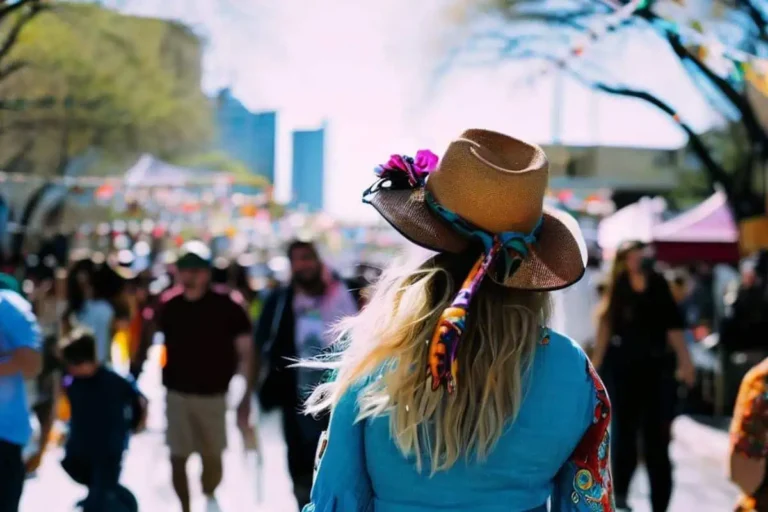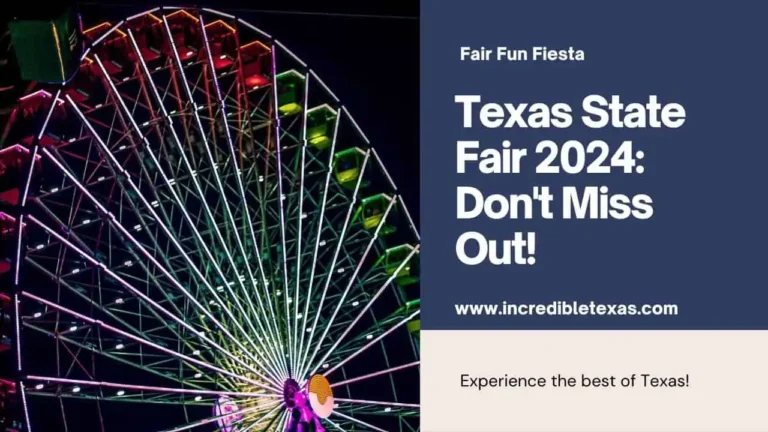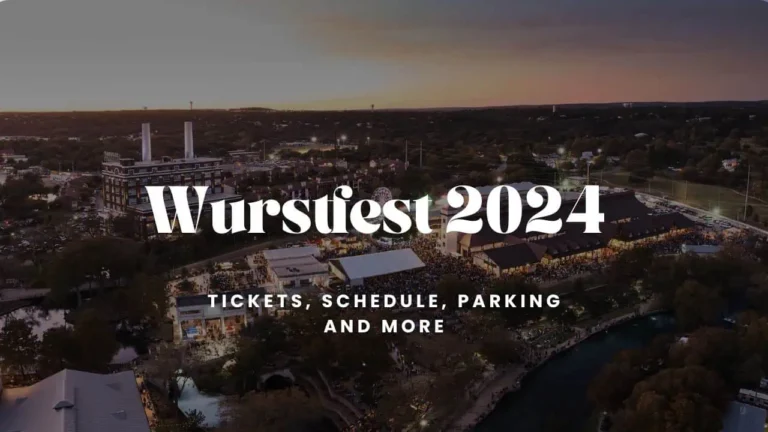The Ultimate Guide to Texas Bluebonnet Trails: Maps, Tips, and Itineraries
Picture yourself cruising a Texas backroad in April, surrounded by rolling fields of bluebonnets. Bursts of red and yellow add to the view as the warm breeze carries the sweet scent of wildflowers. These beloved blooms, the state flower of Texas, transform the landscape into a breathtaking display.
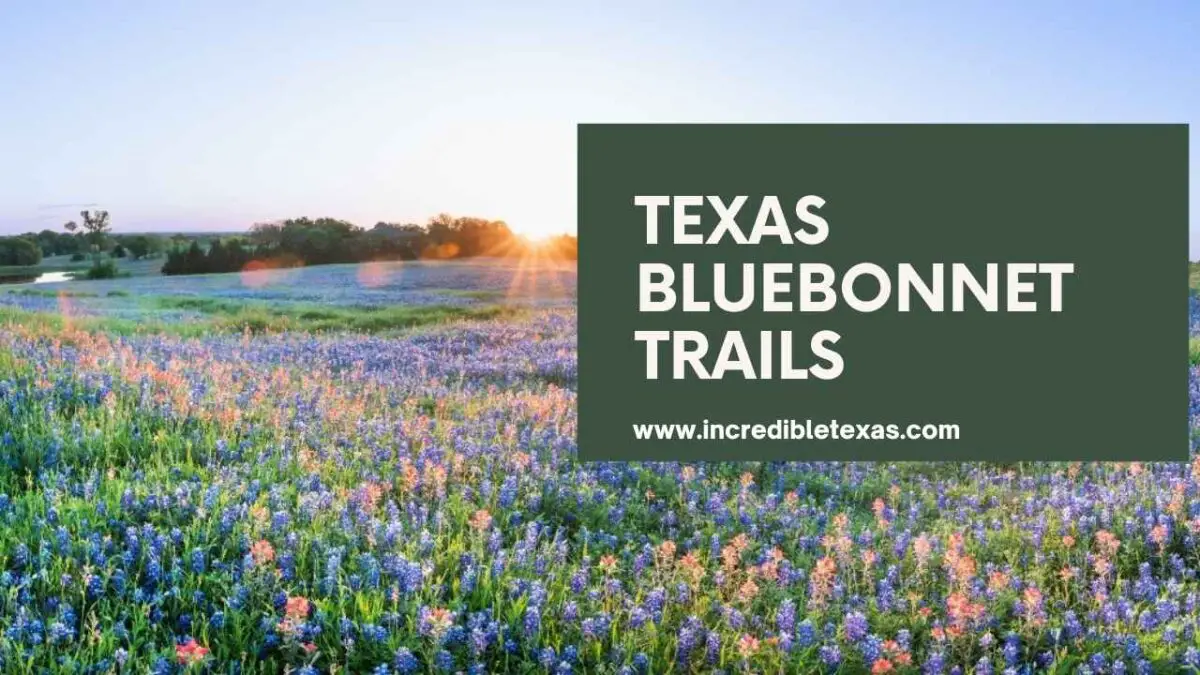
Each spring, highways, fields, and ranchlands burst into color, drawing admirers from near and far. Texans celebrate their bluebonnets with mapped routes showcasing the best displays. Peak bloom usually occurs from mid-March to mid-April, with travelers eagerly searching for the most vibrant fields.
Highways lined with blue pay homage to Lady Bird Johnson’s vision of beautifying Texas roadsides. Beyond the flowers, the scenic drives make this spectacle unique. From the rolling terrain of the Hill Country to the open prairies of North Texas and the rugged beauty of West Texas, these blooms create a postcard-worthy setting woven into Texas culture.
See also: 50 Most Beautiful Places to Visit in Texas: Bucket List
Best Texas Bluebonnet Trails
Texas is a big state with diverse landscapes, and bluebonnets find a way to thrive in many corners of it. Over the years, certain routes have earned a reputation for phenomenal wildflower displays, becoming known as official (and unofficial) “bluebonnet trails.” Below, we’ve gathered the top trails organized by region.
Each area has its own unique scenery – from rolling Hill Country vistas to piney woods lakeshores and desert mountains – but all share the common thread of dazzling bluebonnet blooms when springtime comes knocking.
Hill Country Bluebonnet Trails
When people think of Texas bluebonnets, the Hill Country often comes to mind—rustic fences, longhorn cattle grazing among wildflowers, and rocky hills blanketed in blue. This central Texas region, west of Austin, is classic bluebonnet territory thanks to its sandy limestone soils, which these flowers thrive in.
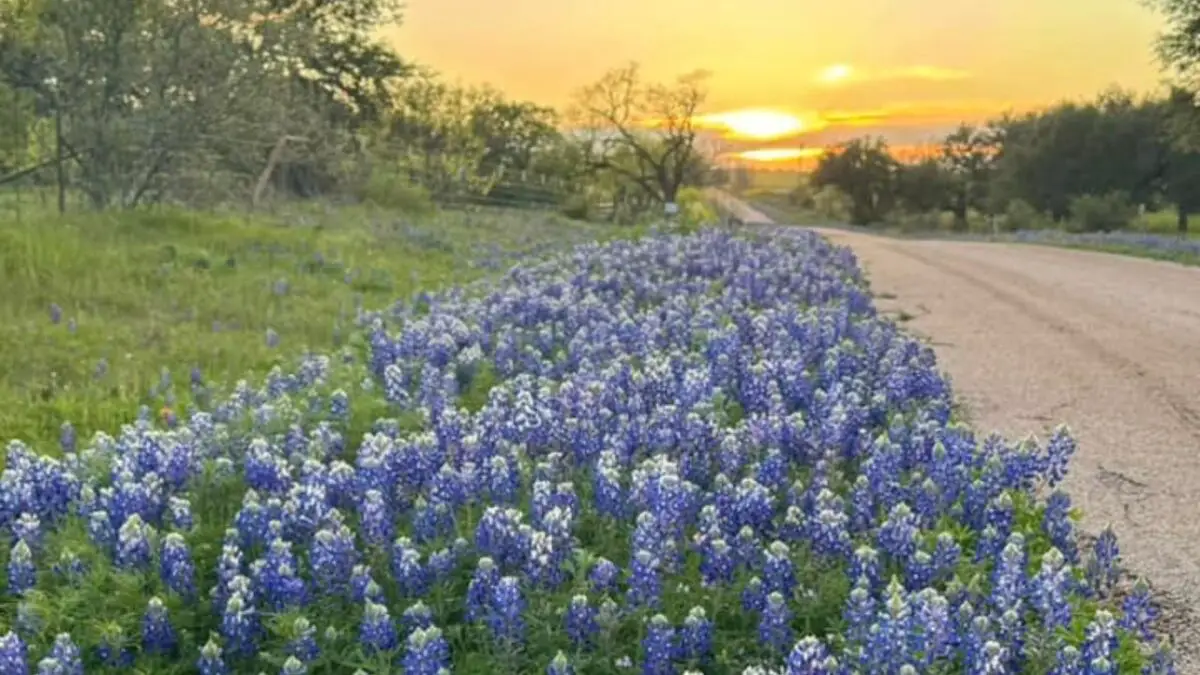
See also: 15 Epic Things to Do in Texas Hill Country
Willow City Loop
This 13-mile loop north of Fredericksburg is a favorite among wildflower lovers. Winding through rugged hills and creek beds, it offers breathtaking views of meadows bursting with bluebonnets, Indian paintbrush, and other blossoms.
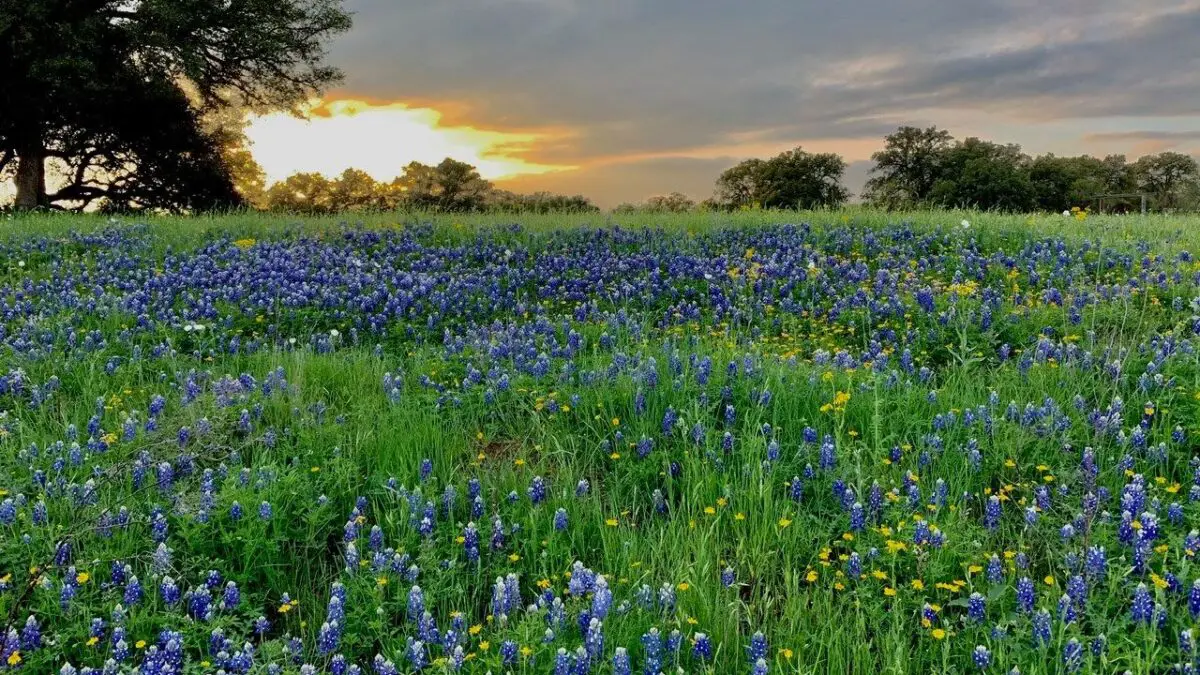
Since all land along the loop is private, visitors must stay on the road. Even from your vehicle, the scenery is spectacular. Early mornings and weekdays offer fewer crowds.
Start in Fredericksburg with a full tank of gas and follow Ranch Road 1323 off Highway 16 for an unforgettable drive.
Highway 16: Fredericksburg to Llano
Not far from Willow City, this scenic stretch of SH 16 is lined with wildflowers in spring. Rolling hills and vibrant roadside blooms create a stunning drive.
A notable stop is Baby Head Cemetery, an old graveyard often surrounded by bluebonnets. As you near Llano, fields of flowers and the meandering Llano River provide a picturesque welcome.
Many travelers combine this route with Willow City Loop for a full-day wildflower tour.
Ennis Bluebonnet Trails
While Ennis is in North Texas, it holds the title of “Official Texas Bluebonnet Trail.” Each April, over 40 miles of mapped routes showcase stunning displays, drawing thousands of visitors.
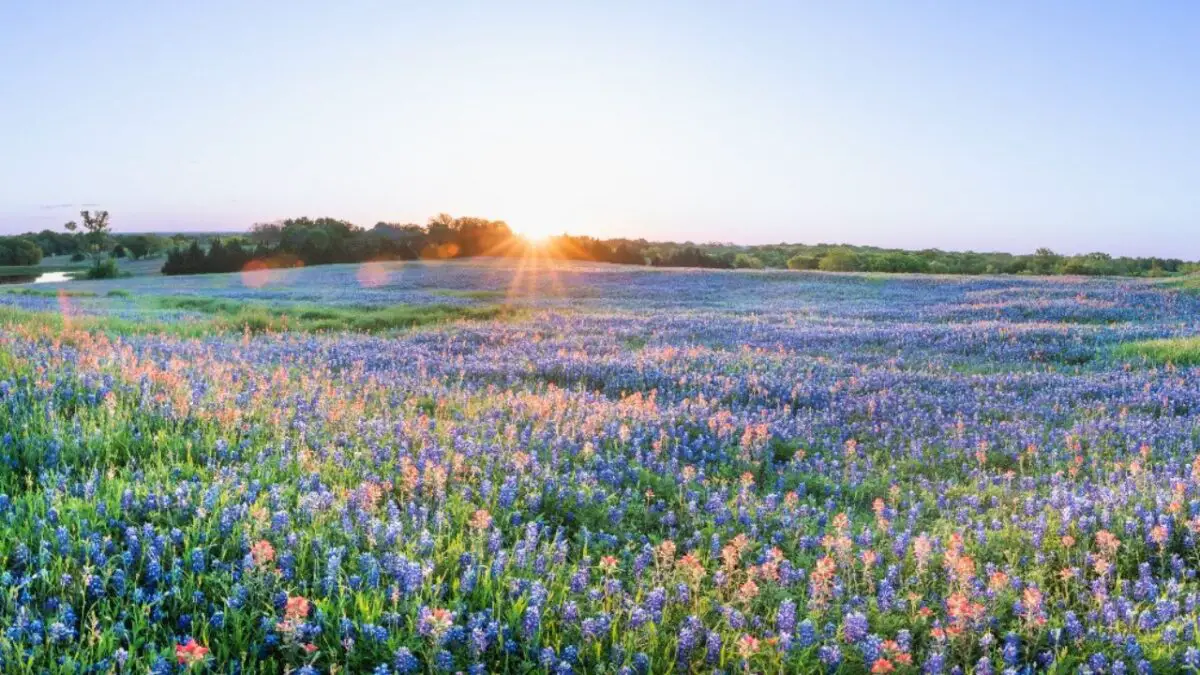
Established in the 1950s, these trails offer a Hill Country-worthy wildflower experience. Ennis’s trails peak around mid-April, making it a must-see for those near Dallas-Fort Worth.
If you’re touring Texas wildflowers, consider starting in the Hill Country in late March and visiting Ennis in mid-April to catch both peak blooms.
North Texas Bluebonnet Trails
North Texas may not be as famous as the Hill Country for bluebonnets, but the prairies and lakes around the Dallas-Fort Worth area offer stunning displays. Bluebonnets in this region tend to bloom slightly later, typically from early to mid-April. Here are some of the best trails and events to explore.
Ennis Bluebonnet Festival
Ennis is North Texas’s bluebonnet capital, featuring over 40 miles of scenic trails. The Ennis Garden Club provides updated bloom maps at the Ennis Welcome Center (201 NW Main St.), helping visitors find the best displays.
Each April, the city hosts the Ennis Bluebonnet Trails Festival, a weekend celebration with live music, food vendors, and craft booths. In 2025, the festival runs from April 11-13, aligning with peak bloom.
The trails weave through ranchlands and rolling fields, offering multiple scenic stops. Bluebonnet Park on the town’s west side provides pedestrian-friendly paths. Arriving early on festival weekend ensures a peaceful drive before enjoying the festivities downtown.
Cedar Hill State Park
Located just 20 minutes south of Dallas, Cedar Hill State Park offers a mix of prairies, woodlands, and lake views. Bluebonnets bloom in open grassy areas, near the campground, and around the historic Penn Farm, where rustic barns provide a classic Texas backdrop.
The DORBA trail also features wildflower displays. A park entry fee applies, but amenities like picnic spots and restrooms make it a great family-friendly outing.
Grapevine and Surrounding Areas
Surprising bluebonnet patches appear throughout the DFW suburbs. In Grapevine, an undeveloped field near the Toyota dealership on Highway 114 often bursts into blue each spring. Grapevine Lake’s shoreline parks, like Rockledge Park, can also offer wildflower displays.
Other local spots include Plano’s Bluebonnet Trail, Freedom Meadow in Frisco, and Oliver Nature Park in Mansfield. While these locations may not offer vast fields, they provide convenient and often uncrowded bluebonnet experiences within city limits.
Central Texas Bluebonnet Trails
Central Texas, home to Austin and stretching toward Houston and the Hill Country, offers some of the most famous bluebonnet destinations. The region’s climate and soil create ideal conditions, and many towns proudly embrace their wildflower heritage.
Burnet – The Bluebonnet Capital of Texas
Burnet (“BURN-it”) welcomes visitors with a giant bluebonnet statue, signaling its dedication to wildflowers. Scenic drives like SH 29 between Burnet and Llano, and Park Road 4 past Inks Lake State Park, showcase brilliant blooms each spring.
The highlight is the Burnet Bluebonnet Festival, held the second weekend of April, featuring a parade, live music, a car show, and over 250 craft vendors. After the festivities, head to Hoover’s Valley or Canyon of the Eagles for breathtaking wildflower views.
Brenham Bluebonnet Trail (Chappell Hill & Washington County)
Northwest of Houston, Washington County boasts 70-80 miles of marked bluebonnet trails. Farm roads like FM 1155, FM 390, and FM 50 weave through rolling pastures and historic sites, including Washington-on-the-Brazos, where Texas declared independence.
Chappell Hill hosts a charming Bluebonnet Festival in April, while Brenham offers a sweet finish—home to Blue Bell Ice Cream. Popular stops include an old railroad trestle and the flower-filled ruins of Baylor University’s original campus in Independence.
Marble Falls & Kingsland – Highland Lakes Drives
Marble Falls, about an hour west of Austin, is known for the iconic Bluebonnet House along Highway 281—a roofless 19th-century stone house surrounded by a sea of blue each spring.
Other scenic routes include FM 1431 to Kingsland and Park Road 4 connecting Inks Lake and Longhorn Cavern State Parks. These drives offer lakeside views and a mix of wildflowers beyond bluebonnets.
Stop at Blue Bonnet Café in Marble Falls for a famous slice of pie after a day of exploring.
East Texas Bluebonnet Trails
East Texas is known for towering pines, azaleas, and dogwoods, but bluebonnets can still be found in select spots. While the sandy, acidic soil isn’t ideal for bluebonnets, a few areas offer delightful surprises alongside other spring wildflowers.
Daingerfield State Park
Nestled in the Piney Woods near Texarkana, Daingerfield State Park is a hidden gem with a tranquil lake and towering trees. Bluebonnets appear sporadically along sunny edges and open meadows, usually in late March or early April.
While not widespread, their presence among dogwoods, violets, and redbud blossoms creates a magical contrast. The 2.4-mile Rustling Leaves Trail is an easy hike for spotting these blooms.
Even if bluebonnets are sparse, the park’s lush greenery and peaceful setting make for a perfect spring getaway.
Tyler & Palestine Areas
While East Texas lacks designated bluebonnet trails, scenic drives near Tyler and Palestine feature diverse wildflowers, sometimes including bluebonnets.
Tyler’s Azalea & Spring Flower Trail in late March showcases azaleas, tulips, and dogwoods, with occasional bluebonnets along roadsides. Around Lake Palestine and Athens, patches of bluebonnets may appear along grassy embankments and open pastures.
Palestine is famous for its dogwood trails, but bluebonnets and Indian paintbrushes can be spotted on farm roads leading toward Crockett.
Highway 287 and nearby FM roads often yield surprising bursts of blue. The wildflower mix in East Texas offers a unique spring experience, blending classic bluebonnets with a rich variety of flora not found elsewhere in Texas.
West Texas & Big Bend Bluebonnet Trails
West Texas, with its mountains, deserts, and wide-open spaces, may not seem like bluebonnet country, but it has its own stunning variety. The Big Bend bluebonnet (Lupinus havardii) is a taller, sometimes deeper-hued cousin of the Hill Country variety, thriving in the desert and creating a unique bloom spectacle.
See also: 20 Hidden Gems in West Texas You Can’t Miss
Big Bend National Park
Big Bend transforms into a sea of blue in wet years, usually from February through March. Unlike dense roadside patches elsewhere in Texas, these bluebonnets grow in scattered formations, often reaching 1 to 3 feet tall. Prime viewing spots include Ross Maxwell Scenic Drive, Old Maverick Road, and the stretch between Castolon and Santa Elena Canyon.
Outside the park, Highway 170 through Big Bend Ranch State Park offers breathtaking views of bluebonnets against the Rio Grande and rugged desert cliffs. Since this is a remote region, plan accordingly with water and supplies.
Fort Davis & Alpine – High-Altitude Wildflower Routes
Bluebonnets and other wildflowers bloom later in the Davis Mountains, typically from late March into April. A 75-mile scenic loop around Davis Mountains State Park via Highways 17 and 118 reveals stunning landscapes dotted with bluebonnets, purple sand verbena, and mountain laurels.
Highway 17 from Fort Davis to Marfa is another excellent route, offering roadside blooms and panoramic desert views. In Alpine, wildflowers can be spotted on the outskirts of town, along roads leading toward Marfa and Marathon.
West Texas bluebonnets are more subtle than the Hill Country’s thick carpets, but their resilience in the arid landscape makes them even more special.
While in the area, consider visiting McDonald Observatory for stargazing or hiking in Davis Mountains State Park to enjoy additional wildflower varieties. West Texas proves that bluebonnets can thrive in even the most unexpected places.
Best Times to Visit for Peak Bloom
Timing is key when planning a bluebonnet trip. While nature can be unpredictable, Texas wildflower experts use seasonal patterns to estimate peak bloom periods.
Peak Months
Bluebonnets typically bloom from March to April. The first flowers appear in South Texas and along the Gulf Coast by early March, with the Hill Country following in late March. Early April is prime time for Central Texas, while North Texas and the Panhandle peak around mid-April. West Texas, especially Big Bend, is an outlier, with bluebonnets sometimes blooming as early as February. By May, most fields have faded, making way for summer wildflowers like Indian blankets and sunflowers.
Month-by-Month Breakdown
- February: Rare early blooms in Big Bend or South Texas.
- Early March: Flowers begin along the I-10 corridor, with early reports from Brenham and Lake Corpus Christi.
- Late March: Hill Country blooms reach full display, with Fredericksburg, Burnet, and Austin’s parks coming alive.
- Early April: Peak bloom across Central Texas, while North Texas (Ennis) starts gaining color.
- Mid-April: Hill Country flowers begin fading, while North Texas and the Panhandle peak.
- Late April – Early May: Remaining blooms in higher elevations (Dallas, Fort Davis), but most regions transition to summer wildflowers.
Weather Impact
Fall rain is crucial for strong bluebonnet seasons. A wet September/October leads to healthy seedlings, while winter moisture sustains growth. Drought or warm winters can weaken blooms, while heavy spring rain can shorten the season. An early warm spell may cause premature blooming, while late freezes can stunt flowers in northern areas.
Tracking Bloom Reports
For real-time updates, check:
- Lady Bird Johnson Wildflower Center (wildflower.org) for statewide forecasts.
- Texas Department of Transportation (TxDOT) for highway bloom reports.
- Community Updates: Ennis Garden Club and Visit Brenham provide detailed trail reports.
- Social Media & Forums: Searching #txbluebonnets or checking Texas travel forums can give real-time bloom updates.
By planning between late March and mid-April and monitoring bloom reports, you can time your visit for the most breathtaking bluebonnet displays—nature’s version of a perfect fireworks show on the ground.
Best Family-Friendly & Pet-Friendly Texas Bluebonnet Trails
Bluebonnet season is a joy for all ages, including young children and pets. Choosing the right spots ensures a safe and fun experience for everyone.
Parks & Public Spaces
State and city parks are ideal for families, offering facilities like restrooms and picnic areas.
- Inks Lake State Park (Burnet) – Trails, picnic spots, and a lake for extra fun.
- McKinney Falls State Park (Austin) – Easy trails with bluebonnets and scenic waterfalls.
- Cedar Hill State Park (DFW) – Flowers and historic farm structures for an educational touch.
- Houston Arboretum & Memorial Park – Stroller-friendly wildflower areas.
- Fort Worth Nature Center – Walking trails and bison viewing, with wildflowers in spring.
Trails for Strollers & Wheelchairs
For smooth paths, consider:
- Bluebonnet Trail Greenbelt (Plano) – A paved, urban trail with wildflower plantings.
- Lady Bird Johnson Wildflower Center (Austin) – Botanical gardens with paved walkways and a sensory garden.
- Ennis Bluebonnet Park & Visitor Center – Wheelchair-accessible viewing areas.
- Highway 290 Scenic Overlooks (Brenham area) – View fields without extensive walking.
Safety & Comfort for Kids
- Dress children in closed-toe shoes to avoid fire ants and prickly plants.
- Bring snacks, water, and a blanket for sitting comfortably.
- Turn flower spotting into a fun game (e.g., counting colors or butterflies).
- Encourage kids to observe, not pick flowers, to preserve the fields.
Pet-Friendly Practices
- Keep dogs on a leash and check the area for fire ants or snakes.
- Prevent pets from trampling flowers and always clean up waste.
- Be mindful of allergies—pollen can cling to fur.
Educational & Accessible Experiences
- Washington-on-the-Brazos State Historic Site – Combines history with wildflowers.
- LBJ State Park (Stonewall) – Features flowers, exhibits, and Texas wildlife.
- Wildseed Farms (Fredericksburg) – Flat, easy-to-navigate wildflower farm with a beer garden.
For those with limited mobility, scenic drives like Willow City Loop or Ennis Bluebonnet Trails allow for breathtaking views without strenuous walking.
Road Trip Itinerary Ideas
Turn bluebonnet season into a road trip! Whether you have a weekend or a single day, these itineraries will help you experience the best blooms without feeling rushed.
Weekend Getaway Route (2-3 Days)
Hill Country Wildflower Loop (3 Days)
Day 1 – Arrival in Hill Country:
- Drive to Fredericksburg via the most scenic route from your location.
- Stop in Brenham/Chappell Hill (if en route) for a quick wildflower tour and lunch.
- Check into a Fredericksburg B&B or hotel.
- Enjoy Main Street shopping or a winery visit in the evening.
Day 2 – Hill Country Bloom Tour:
- Start early with the Willow City Loop drive for stunning morning light.
- Head north to Llano via Highway 16 for BBQ lunch at Cooper’s BBQ.
- Continue east on Hwy 29 to Burnet, part of the Highland Lakes Bluebonnet Trail.
- Explore Burnet’s bluebonnet displays or catch the Bluebonnet Festival (mid-April).
- Drive Park Road 4 past Inks Lake and Longhorn Cavern State Park for a final scenic stretch.
- Stop at the Bluebonnet House (Marble Falls) before returning to Fredericksburg.
Day 3 – Luckenbach to Ennis (or Austin)
- Option A: Head east to Ennis (4-hour drive). Stop at the Lady Bird Johnson Wildflower Center (Austin) along the way. Explore Ennis Bluebonnet Trails and stay overnight if possible.
- Option B: Stay central—visit Luckenbach, then drive south through Medina & Bandera, ending in San Antonio for sightseeing.
Customizing Your Trip
- From Dallas? Start with Ennis, then head to Hill Country.
- From Austin? Make a tighter loop through the Hill Country.
- Prefer a slower pace? Focus on one region instead of multiple.
No matter your route, a Texas bluebonnet road trip promises breathtaking scenery and unforgettable memories!
One-Day Scenic Drive
Short on time? A single day can still be magical. Here are a few scenic routes for a quick yet unforgettable bluebonnet adventure.
Austin to Marble Falls Loop
- Start in Austin, taking FM 2244 (Bee Caves Rd) west to Hwy 71.
- Just before Marble Falls, detour 1 mile north on Hwy 281 to see the Bluebonnet House in the morning light.
- Continue west on FM 1431 toward Kingsland, enjoying lake and wildflower views.
- Stop for lunch at Grand Central Café (famous for chicken-fried steak).
- Loop back via RR 2900 to Hwy 71 past Packsaddle Mountain.
- Visit Muleshoe Bend Recreation Area near Spicewood for a breathtaking lakeside bluebonnet display.
- Return to Austin via Hwy 71 (Total drive: ~2.5 hours, not counting stops).
Dallas/Fort Worth to Ennis
- Drive 35-45 minutes south of Dallas to Ennis.
- Stop at the Ennis Welcome Center for the latest trail map.
- Spend late morning exploring the Ennis Bluebonnet Trails, covering multiple scenic loops.
- Picnic along Sugar Ridge Road or enjoy a diner lunch in downtown Ennis.
- Optional: Stop at Cedar Hill State Park on the way back for lake views and wildflowers.
- Return home by dinner with a camera full of bluebonnet memories.
Houston to Brenham/Chappell Hill
- Take US 290 W to Chappell Hill, spotting roadside blooms.
- Explore Chappell Hill and continue via FM 1155 & FM 390 (La Bahía Scenic Highway) for rolling wildflower fields.
- Stop at Baylor College ruins in Independence for a scenic break.
- Lunch in Brenham—picnic at Fireman’s Park or try a local café.
- Drive south via FM 2447 to Burton, then loop back via Highway 290.
- Optional: Detour to Washington-on-the-Brazos State Historic Site for late-day blooms before returning to Houston.
Pro Tips for One-Day Trips
- Plan fuel, food, and rest stops in advance.
- Aim for sunrise or sunset views for breathtaking lighting.
- Keep an eye on time—it’s easy to get lost in the beauty of the fields!
With careful planning, even a single day among the bluebonnets can feel like a perfect getaway.
Camping & Lodging Recommendations
If your bluebonnet adventure spans more than a day, Texas offers a variety of accommodations, from rustic campsites to charming B&Bs. Here’s where to stay:
Camping Under the Stars
- Inks Lake State Park (Burnet) – Lakeside camping with wildflowers along trails.
- Enchanted Rock State Natural Area – Hike the pink granite dome at sunset, then stargaze.
- Pedernales Falls State Park – Scenic river views with wildflowers in spring.
- Tyler State Park – Dogwood blooms and peaceful lakeside camping.
- Big Bend National Park & Ranch State Park – Desert bluebonnets and breathtaking night skies.
- Lake Somerville State Park – Known for trails lined with bluebonnets.
RV Parks & Glamping
- Big Chief RV Park (Lake Buchanan) – Near Burnet’s bluebonnet trails.
- Fredericksburg & Marble Falls RV Parks – Some vineyards even offer RV hookups.
- Glamping Options – Search Airbnb or Hipcamp for safari tents, cabins, or “wildflower farm stays.”
Bed & Breakfasts & Small Inns
- Fredericksburg – Dozens of scenic B&Bs, some with private wildflower fields.
- Llano & Burnet – Quaint riverside stays with easy access to blooms.
- Ennis & Waxahachie – Historic inns near North Texas bluebonnet trails.
- Washington County (Brenham/Chappell Hill) – Farm B&Bs with rolling wildflower fields (e.g., Lillian Farms).
- East Texas (Palestine & Jefferson) – Ideal for wildflower and dogwood trail stays.
Hotels & Motels
- Fredericksburg & Marble Falls – Book early; high demand in wildflower season.
- Burnet, Llano, & Ennis – Chain hotels and motels with convenient trail access.
- Austin & San Antonio – Great bases for day-tripping to wildflower regions.
Unique Stays
- Burton/Brenham Historic Cabins – 1800s farmhouses with wildflower views.
- Flying L Ranch Resort (Bandera) – Wildflowers and cowboy-style lodging.
- Round Top Area (La Grange) – Trendy cottages in scenic countryside.
- Terlingua Ghost Town (Big Bend) – Desert casitas with stunning landscapes.
Booking Tips
- Spring is peak season—reserve early.
- Check nearby alternatives if your first choice is full.
- Consider flexibility: Stay in Kerrville instead of Fredericksburg or Waxahachie instead of Ennis.
Whether camping under Texas stars or relaxing at a cozy inn, your bluebonnet trip will be unforgettable!
Events & Festivals Celebrating Bluebonnets
Springtime in Texas means bluebonnet festivals, where wildflower beauty meets live music, local food, and small-town charm. Here are some must-visit events:
Ennis Bluebonnet Festival (April 11-13, 2025)
- Held during peak bloom, this festival turns downtown Ennis into a lively celebration.
- Enjoy live music, a wine and beer garden, arts and crafts, and family activities.
- Guided trail tours by the Ennis Garden Club offer expert-led bluebonnet viewing.
- Arrive early for fewer crowds; don’t miss the local Bluebonnet Market for seeds and plants.
Burnet Bluebonnet Festival (April 12-14, 2024)
- One of the largest bluebonnet events, drawing 30,000+ visitors.
- Features a Grand Parade, carnival rides, classic car show, and live concerts.
- Check out the Highland Lakes Birding & Wildflower Show and craft vendors.
- Nearby scenic drives (Hwy 29, Park Road 4) let you enjoy flowers after the festival.
Chappell Hill Bluebonnet Festival (Second Weekend of April)
- Officially named the “Bluebonnet Festival of Texas.”
- Over 250 vendor booths selling crafts, antiques, and handmade goods.
- Family-friendly with kids’ activities, historical exhibits, and farm displays.
- Surrounded by bluebonnet-covered pastures, making for easy post-festival exploring.
Other Notable Events
- Llano Earth Art Fest (March) – Includes wildflower talks and self-guided bluebonnet trails.
- Zilker Garden Festival (Austin, late March) – Not a bluebonnet fest, but a major garden event during wildflower season.
- Florence Bloomin’ Fest & Kingsland Wildflower Festival – Local events with seasonal flair.
- Big Lake Wildflower Love Event – A West Texas celebration of spring blooms.
Attending a bluebonnet festival adds an extra layer of fun to your trip—combining wildflower viewing with Texas hospitality, music, and delicious fair treats. Don’t forget sunscreen, a hat, and a tote bag for all the goodies you’ll want to bring home!
Other Wildflowers You Might See
While bluebonnets steal the spotlight, Texas fields are alive with a colorful array of wildflowers. Here are some standout blooms to watch for:
Indian Paintbrush (Castilleja indivisa)
- Bright red-orange flowers that often grow alongside bluebonnets, creating a stunning contrast.
- Semi-parasitic, attaching to nearby plants for nutrients.
- Occasionally found in yellow or white variations.
Mexican Hat (Ratibida columnifera)
- Distinctive red-and-yellow petals with a tall central cone resembling a sombrero.
- Blooms from late April into summer, often appearing as bluebonnets fade.
Winecup (Callirhoe involucrata)
- Deep magenta, cup-shaped flowers sprawling on vine-like stems.
- Often found along rocky edges of bluebonnet fields.
- Closes in the afternoon sun, resembling a “sleeping” flower.
Coreopsis (Coreopsis tinctoria)
- Cheerful yellow flowers with maroon centers, blooming from April through summer.
- Often seen in highway medians and mixed wildflower fields.
Indian Blanket (Gaillardia pulchella)
- Also known as firewheel, featuring red centers with yellow-tipped petals.
- Appears in late spring, replacing bluebonnets in many fields.
Other Wildflowers to Spot
- Pink Evening Primrose – Delicate pink cup-like blooms lining roadsides.
- Black-eyed Susans & Engelmann’s Daisy – Bright yellow wildflowers common in late spring.
- Purple Horsemint (Bee Balm) – Lavender-pink clusters appearing in May-June.
- Blue-eyed Grass – Tiny, star-like blue blooms, actually an iris relative.
Wildflower season evolves as spring progresses, shifting from blues and reds to yellows, pinks, and oranges. Taking the time to notice these lesser-known blooms enriches the experience, making each field a unique and vibrant tapestry of Texas nature.
